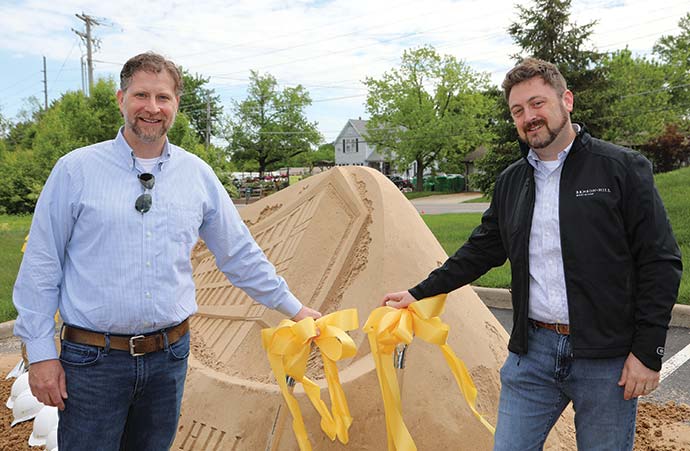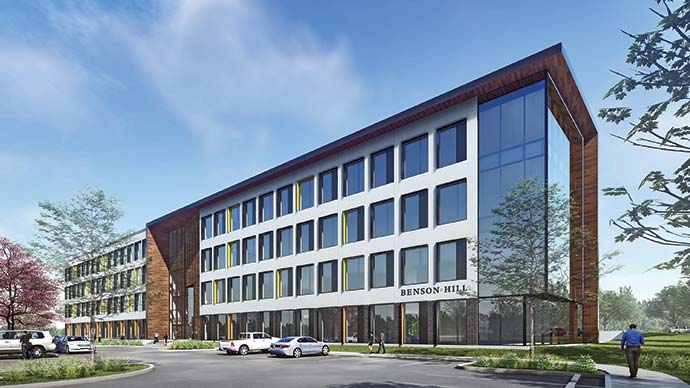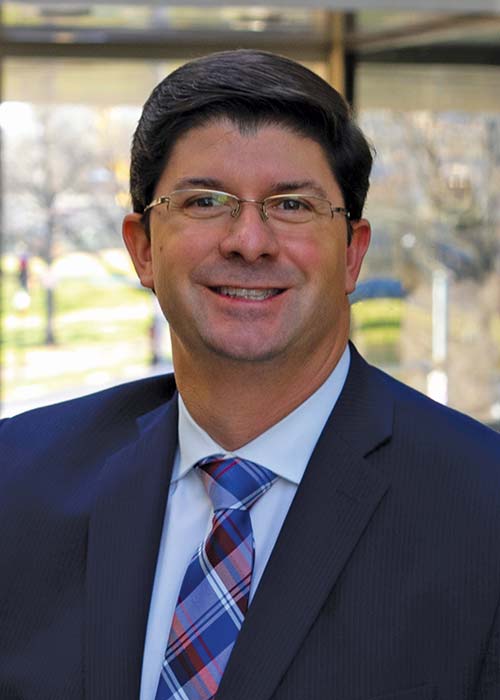The USDA wants to relocate offices from D.C. to KC. The University of Missouri is partnering with Siemens Healthineers to form the Alliance for Precision Health, with Mizzou just breaking ground in Columbia for its NextGen Precision Health Institute, expected to open its doors in fall 2021. Pfizer in May opened its new $236 million R&D complex in Chesterfield, west of St. Louis. Then Bayer’s North American Crop Science division decided in July to relocate its commercial headquarters and 500 high-paying jobs to nearby Creve Coeur.
It’s fair to say Missouri’s on a life sciences roll. Momentum breeds further momentum, and if you follow the trail long enough, you close the loop of a thriving business ecosystem.
In August, Bayer followed up its HQ news by awarding BioSTL — a St. Louis-based non-profit which advances and promotes the region’s growing bioscience, innovation and technology community — a $1.5 million grant to support its own new and expanded headquarters at St. Louis’ Cortex Innovation Community. In August, agriculture, food and ingredients company Bunge announced it will relocate its global HQ from White Plains, New York, to Chesterfield, where it will consolidate at the site of its North American HQ.
“While St. Louis is already an important hub for Bunge and our current North American operations, the city is also home to a number of food, agriculture, animal health and plant science organizations and customers,” said Gregory A. Heckman, Bunge’s CEO. “Moving the global headquarters to a location where Bunge has a major business presence is a big step forward in shifting the company’s operating model to align around a more efficient, streamlined global business structure.
Sunlight for Growth
Bunge is a JV partner with DuPont in another company whose HQ is in St. Louis: Solae, the soy protein-focused company whose headquarters is just across the way from Cortex in the Central West End neighborhood (positioned between St. Louis University and a cluster of hospitals). Solae’s research heritage extends back to one of the city’s legacy corporations, Ralston Purina, founded in 1895 by William H. Danforth, an 1892 graduate of Washington University. His name now graces the Danforth Plant Science Center. And that’s where, in May, Benson Hill Biosystems, a crop improvement company unlocking the genetic diversity of plants, broke ground on its 160,000-sq.-ft. headquarters building at the Danforth Center’s EDGE@BRDG site.

“We chose to expand our presence in St. Louis because of its leadership in plant science and commitment to innovation,” said Matthew Crisp, CEO and co-founder of Benson Hill. “Dr. Danforth’s vision to build an ecosystem in food and agriculture was fostered by stakeholders across the St. Louis community, and Benson Hill is an example of those efforts coming to fruition. We’re excited to contribute to the growth and opportunity of the St. Louis region and to the evolution of a more healthy and sustainable food system.”
Benson Hill was launched in 2012 to improve the photosynthetic efficiency of crops using a proprietary computational platform. The company has licensed some technologies from the Danforth Center, which is the largest independent plant science research center globally, attracting global talent to do nothing but generate intellectual property.
Benson Hill already had moved from Research Triangle Park (RTP) in North Carolina to the Helix Center in St. Louis, just down the road from the Danforth. The company has raised over $100 million in venture funding, most recently in a Series C financing round garnering $60 million that was led by GV, the venture capital arm of Alphabet. It’s grown to 117 employees with plans to house a total of 300 employees in the new facility.
In an interview, Matthew Crisp, who co-founded Benson Hill with Todd Mockler, says when a company is little more than a couple people with an idea, investment capital is the top priority, followed swiftly by the need for talent and for infrastructure (wet labs, greenhouses, etc.) geared toward the firm’s specific needs. “There are not a whole lot of hubs available with that infrastructure for early-stage companies,” he says.

Likewise, ag-tech and plant sciences talent with expertise in crop physiology or molecular biology is already tightly clustered in the employ of a small list of top companies with names such as Monsanto and Bayer, whose footprints are consolidated in a handful of regions. St. Louis had all the ingredients, including — perhaps to some observers’ surprise — the money.
“What solidified Benson Hill was investment capital, which we were able to raise here in St. Louis at a rate we weren’t able to raise elsewhere,” Crisp says. Institutional capital came next. By 2015 the firm was up to 15 people split between North Carolina and St. Louis, “but the Danforth facility kept accommodating us, and we kept getting capital locally as well as drawing from the coast,” he says. “We reached a critical mass, decided St. Louis was home for us, and made the decision to consolidate all laboratories and offices under one roof.”
Greenhouses and Ecosystems Aren’t Just Metaphors
RTP was really the only other candidate for the move, Crisp says, calling the two areas the two “epicenters of plant science and infrastructure.” A decade ago, he says, RTP didn’t have good infrastructure for early-stage companies or a robust ag tech investment ecosystem, but Alexandria Real Estate Investment Trust has changed that with its new ag-tech cluster and seed funds established there early this year.
But Benson Hill already had a good thing going at Danforth, which he calls “the catalyst to not just stay but stay and grow successfully.” The center also had something else of very concrete value: greenhouses. “They are important infrastructure, difficult to find and very expensive,” Crisp says. “It was something Danforth had early on.”

There were other contributing factors too, not least of which was a partnership signed during the first quarter of 2019 with AB InBev, owners of the company most identified with St. Louis, Anheuser-Busch. Benson Hill will work with the brewer to develop more productive and sustainable barley varieties that use less water and other natural resources. In addition, in March, Benson Hill acquired the assets of Iowa-based Schillinger Genetics, also known as eMerge Genetics, a company currently delivering novel high-yielding, high-protein non-GMO soybean varieties.
“Other than California, where you have a lot of specialty crops, the middle of the country is where a significant majority of the ag infrastructure is developed for our country, and for that matter, a lot of the world,” says Crisp. “The middle part of the United States is a more productive, fertile environment than almost any ecosystem globally from an ag standpoint.”
California dwarfs everyone else when it comes to venture capital, he says, “but we have our own set of value propositions in the middle of the country — not just the early stage capital that helped anchor us there, but we’re surrounded by 500 miles of ag and farming in every direction.”
Being in the same metro area as several national crop associations is great for stakeholder engagement, Crisp says, especially as Benson Hill positions itself to be of value to both the grower community and the consumer side of the value chain. “We’re being purposeful in using the tools and technologies to power innovation and supply benefit to both sides,” he says.
Recruitment has not been an issue, Crisp says, with 43% of employees relocating to St. Louis, where the company this spring had doubled in size within a year and employed nearly 120. “We, along with half a dozen other small companies, are within this 39 North Innovation District focused on ag and food,” Crisp says of the growing momentum in the direct neighborhood. “There’s a critical mass building, and that will expand as more talent comes out of the big companies that are still consolidating.”
He says big, incumbent companies “are beginning to realize that innovation from small organizations willing to think beyond incremental improvements is becoming of extraordinary value.”
That makes ecosystems like the one St. Louis has nurtured among the industry’s most valuable players.
Rural Missouri Rakes Up, Tackles Broadband
Missouri scored a hefty haul of investment in regions outside the state’s three largest cities over the past year. The Missouri Partnership, the public-private development organization that helps attract new business to the state, reports that it partnered on rural economic projects totaling more than $280 million from July 2018 through June of this year. The Partnership says rural investments accounted for 379 new jobs and more than $18 million in annual payroll.
“On a percentage basis, these projects accounted for 76% of the capital investment, 26% of the new jobs created, and 22% of the new annual payroll created statewide through projects we were involved with in FY2019,” says Subash Alias, the Partnership’s CEO. “These rural wins had an average wage of more than $50,000 per job and are transforming the lives of our residents across the state.”
GESS International, which turns farm waste into renewables, announced plans to construct five biogas plants in Audrain, Chariton and Miller counties, investments expected to total $185 million and create more than 100 rural jobs.

Empire Comfort Systems broke ground in May on a manufacturing facility that represents a $10 million investment projected to create 140 jobs in Poplar Bluff, known as the gateway to the Ozarks in the southeastern part of the state. The Empire facility will be the first manufacturing plant to be built from the ground up in the Poplar Bluff Industrial Park in 30 years. Iowa-based Central Service and Supply, another advanced manufacturer, is completing a 150,000-sq.-ft. facility in Macon, just under an hour’s drive north of Columbia.
Smith Seed Services picked the southwestern Missouri city of Lamar for a Midwest seed coating plan expected to create 40 new jobs.
“This company chose our state because of the great community in Lamar, the strong agricultural industry in Missouri, and our central location which allows them to reach key customers in the Midwest,” said Missouri Gov. Mike Parson.
Those big wins aside, rural Missouri faces a challenge common to other areas: a lack of access to broadband internet. Missouri, according to Broadbandnow.com, is ranked 41st in the country for broadband connectedness, with just over 36% percent of Missourians enjoying access to 1 gigabit broadband.

“It’s a missed opportunity for farms when they cannot fully deploy precision agriculture technology.””
Missouri’s shortage of broadband access cuts in multiple directions, according to Tim Arbeiter, director of broadband development for the Missouri Department of Economic Development. Missouri, he says, has well over 1 million citizens without high speed internet.
“Certainly, we’ve lost opportunities from a business standpoint,” Arbeiter tells Site Selection, “starting with agriculture, which is the leading industry for our state. It’s a missed opportunity for farms when they cannot fully deploy precision agriculture technology. Every farm that’s fully able to access precision ag technologies could see 6% growth in their ag revenue. Forty-seven thousand Missouri farms indicate they don’t have access to high-speed internet. Multiply it out, and that’s huge,” Arbeiter says.
In June, the Federal Communications Commission announced new federal broadband funding for Missouri totaling around $24 million over the next decade. The money is from the federal government’s Connect America fund created to close the digital divide in rural America. Missouri’s Rural Broadband Development Fund received $5 million from the state budget passed in May.
“Five million dollars might not seem like a lot in the broadband space,” says Arbeiter, “but it’s a start for us.”

